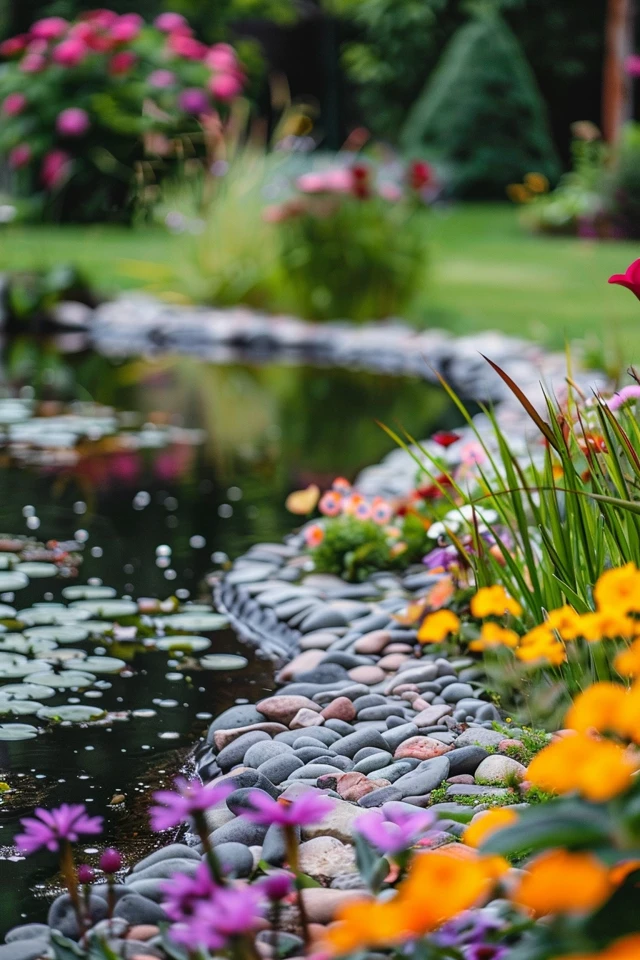When it comes to enhancing the edge of your pond and creating an attractive water feature, there are various creative pond edging ideas to consider. Stones and rocks are a popular choice for pond edging, providing a natural and rustic look. Pebbles can be placed around the edge of the pond, hiding the lining material and keeping it securely in place.
Natural stone and rocks come in different shapes and colors, allowing you to choose the best options that suit your environment. To create a rustic-style edging, mix different sizes of pebbles, including large, medium, and small ones. Trailing plants and tall grass can also be used as edging options, providing hiding spots for wildlife and adding color to the pond’s edge.
Other materials such as paving tiles, bricks, wooden logs, and concrete can also be used for pond edging, each offering their own unique look and functionality. Consider incorporating plants such as irises, watercress, canna lilies, and hostas for a more natural and vibrant pond edge design. With these creative pond edging ideas, you can enhance the beauty and functionality of your backyard oasis while creating a habitat for wildlife.
Key Takeaways:
- Pebbles and stones provide a natural and rustic look for pond edging.
- Trailing plants and tall grass can be used as edging options, adding color and providing hiding spots for wildlife.
- Paving tiles, bricks, wooden logs, and concrete are alternative materials for pond edging, each with its own unique look and functionality.
- Incorporating plants like irises, watercress, canna lilies, and hostas can enhance the natural and vibrant design of the pond edge.
- By choosing the right pond edging materials and incorporating creative ideas, you can enhance the beauty and functionality of your backyard pond while creating a habitat for wildlife.

Choosing the Right Pond Edging Material
When it comes to pond edging, selecting the right material is crucial to achieve the desired design and style. There are various options available, each offering its own unique look and functionality. Let’s explore some popular choices:
Stone Pond Edging
Stone is a versatile option that can create a rustic and natural look for your pond. Pebbles and natural stones, such as river rocks, can be easily placed around the edge of the pond, providing a secure base while hiding the lining material. Mixing different sizes and colors of stone can enhance the visual appeal of the pond edges.
Paving Pond Edging
Paving tiles offer a low maintenance option for pond edging. Whether laid horizontally or vertically, these tiles can create a unique and eye-catching look. With a variety of colors and patterns available, you can customize the edging to complement your outdoor space.
Wooden Decking Pond Edging
If you prefer a rustic and natural pond edge, wooden decking is an excellent choice. The warmth and texture of wood can enhance the overall aesthetics of your pond. It provides a smooth and inviting surface for outdoor seating and offers a seamless transition between the water and the surrounding landscape.
Concrete Pond Edging
For a sleek and formal finish, consider concrete pond edging. It offers a clean and polished look that complements modern and contemporary designs. Concrete can be poured and shaped to create custom edging designs, adding a touch of sophistication to your pond.

Brick Pond Edging
Brick pond edging is a classic choice that can create a timeless and elegant look. It can be used to build raised areas or feature areas around the pond, adding depth and visual interest to the overall design. With different brick patterns and colors available, you can personalize your pond edging to match your style.
When choosing the right pond edging material, consider your personal preferences, landscape design, and the atmosphere you want to create. By selecting the material that best suits your aesthetic and functional requirements, you can enhance the beauty and allure of your backyard oasis.
Tips for Installing Pond Edging
When it comes to installing pond edging, there are a few key tips to keep in mind to ensure a successful project and create a beautiful water feature in your backyard.
First and foremost, it’s crucial to decide on the edging method you want to use before starting the excavation process. This will help you plan and prepare accordingly, ensuring a seamless installation.
Footings are essential for most pond edging options, providing stability and support. When constructing the footings, make sure to use ample concrete and a strong mix to ensure their durability. It’s also recommended to use an underlay if the pond liner comes into contact with the footings or walling, providing an extra layer of protection against any sharp edges.

Another important aspect to consider is hiding any cables or pipes within the edging. This will not only enhance the aesthetic appeal of your pond but also ensure functionality and convenience. Additionally, it’s a good idea to add spare ducts during installation to accommodate any future needs or changes.
When working with cement, it’s essential to remove any debris that falls into the pond during construction. This will prevent any potential harm to the pond’s ecosystem and ensure a safe and clean environment for your aquatic plants and fish. Before introducing any plant or fish life, it’s recommended to do a complete water change a few days after any cement work to ensure the pond is safe.
Finally, if you’re installing a preformed shaped pond, use sand to create a leveled base. Refer to the manufacturer’s instructions for specific installation guidelines to ensure proper leveling and alignment.
By following these pond edging tips, you can install your pond edging with confidence, creating a stunning focal point in your backyard and enhancing the overall beauty of your outdoor space.

